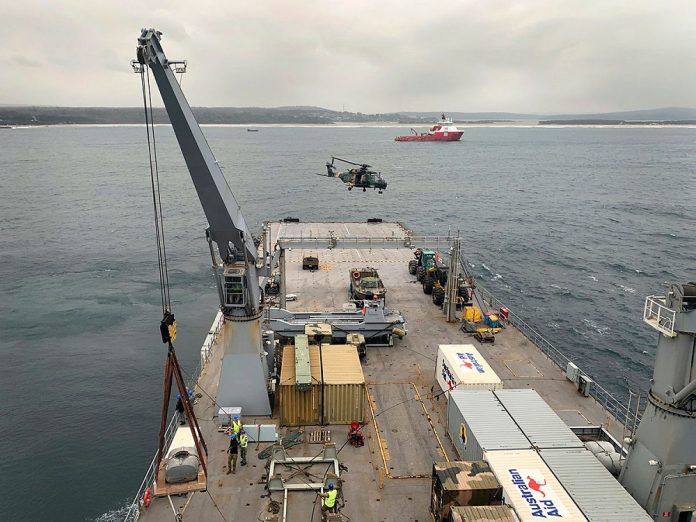
By Peter Court*
Australia’s ports may be busy, but we have no way of ensuring that ships will keep coming to them in wartime. In an age of contested supply chains, strategic competition and rising instability, this absence of Australian shipping capacity poses one of the country’s most underappreciated national security risks. (From The Strategist. The Australian Strategic Policy Institute.)
To take national resilience seriously, the federal government must decisively rebuild sovereign control over a degree of international shipping capacity. That starts with revitalising the moribund Australian International Shipping Register (AISR) as a credible, competitive and security-aligned mechanism for rebuilding a merchant fleet. Appropriate government stimulation of similar registry regimes in comparable economies has proven to deliver a core of commercial maritime resilience.
The current incentive, an exemption from tax for earning of ships that are on the AISR, isn’t enough. In return for the exemption, each ship must be available for requisition and have at least two Australians aboard in management roles (typically those of captain and chief engineer) and three trainees to create a supply of new officers.
Possible further incentives, which would need detail investigation, might include an initial round of grants or favourable loans to fund a few ships that would re-establish the industry. Another might be the government taking minority ownership of ships.
For decades, successive governments have allowed our maritime capability to wither. In the 1980s, Australia maintained a fleet of more than 120 internationally trading ships of varied types, including tankers and container carriers. Today, we effectively have none. Our current capacity comprises just a handful of vehicle and passenger vessels serving Tasmania, an icebreaker and one self-discharging bulk carrier. Requisitioning these vessels in an emergency would cut lifelines to the island state and offer no depth or diversity in capability.
Meanwhile, other maritime nations, including Japan, Britain, France, Denmark, Norway and Israel, along with most other OECD countries and even landlocked Switzerland, have maintained significant international fleets on registries similar to our AISR. Vessels that serve commercial markets in peacetime and can be called upon in times of crisis. Australia has taken the opposite path, ceding control to market forces and allowing national capability to evaporate.
During the Covid-19 pandemic, global shipping schedules collapsed, leaving Australian supply chains vulnerable. Industries scrambled for goods, while empty shelves and spiking freight costs highlighted our dependence on foreign operators. But even this systemic shock failed to trigger reform. The AISR—designed to provide a competitive platform for Australian-flagged international vessels—remains unused, ignored by industry and neglected by the government.
This must change. Reviving the AISR is the fastest and most cost-effective path toward restoring sovereign shipping capability. It offers a viable structure to encourage Australian companies to register vessels under national control without sacrificing competitiveness or flexibility. More importantly, it allows the federal government to create a requisition-ready merchant fleet that can operate in times of crisis.
The benefits of revitalising the AISR extend beyond emergency logistics. It would generate workforce pathways for Australian deck and engineering officers, many of whom currently lack opportunities to accrue the sea time required for qualification. Without ships, there is no workforce, and without a workforce, there is no capability.
Reestablishing a sovereign shipping sector would also revitalise the broader maritime ecosystem. Greater activity and certainty would benefit ship management, port services, logistics, training and regulatory expertise, strengthening our national resilience.
Importantly, the cost would be marginal. For context, a defence budget equivalent to 3 percent of GDP would equate to more than $75 billion annually. That’s roughly $1.44 billion weekly, or $206 million daily. The funding required to sustain a viable AISR—estimated at $40 million to $50 million annually—represents less than a third of one day’s defence expenditure.
That raises a serious question: If we are willing to spend hundreds of millions each day to prepare our military for a contested future, why are we not willing to spend a fraction of that to secure the logistical backbone those forces will rely on? Sovereign shipping is not a boutique capability—it is an essential enabler of national power.
To operationalise this strategy, the federal government should:
—Reinvest in the AISR with incentives and regulatory support, such as those mentioned above, to make it an attractive, viable platform for Australian-controlled shipping companies;
—Set clear targets to increase Australian-flagged merchant vessels, including capacity for key cargo classes: fuel, food, bulk commodities and defence-related materials; and
—Develop a maritime skills strategy aligned to the AISR, ensuring reestablished and expanded training pipelines for maritime officers, engineers and shore-based support.
Australia’s national security strategy must move beyond platforms and posture. It must include the often unseen logistics that enable power projection, humanitarian assistance and economic continuity. Without ships, Australia cannot move. Without maritime workforce development, we cannot crew. And without a policy reset, we will remain dependent on foreign goodwill when it matters most.
It is time to shift the conversation. We must see sovereign shipping not as nostalgia or economic protectionism but as a form of critical infrastructure. The next crisis will not wait for capability to catch up. While the seas are calm, we must invest now to ensure we are ready when they turn rough.




Peter Court’s article is timely and vitally important. This extreme maritime vulnerability is hiding in plain sight and consequently ignored. These are the years when something might be done to revive an Australian merchant marine before the next maritime supply crisis is upon us. I concluded my article on the same lack of action with Churchill’s observation about lack of escorts: ‘ when this problem was soluble it was ignored. Now that is thoroughly out of hand be propose too late the remedies that would have prevented it! ‘ I think that sums up what Peter has stated in his excellent analysis of where we are currently placed.
Peter, I completely agree with everything you say. I am also concerned, because we lack active and experienced seafarers there is no community to act as advisors to either State or Federal governments, consequently the subject is overlooked. The number of ports with Australian Harbour Masters is declining and suitably qualified national maritime pilots are mostly retiring, exacerbating the problem.